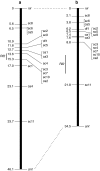Molecular mapping of restorer-of-fertility 2 gene identified from a sugar beet (Beta vulgaris L. ssp. vulgaris) homozygous for the non-restoring restorer-of-fertility 1 allele
- PMID: 25287614
- PMCID: PMC4236623
- DOI: 10.1007/s00122-014-2398-4
Molecular mapping of restorer-of-fertility 2 gene identified from a sugar beet (Beta vulgaris L. ssp. vulgaris) homozygous for the non-restoring restorer-of-fertility 1 allele
Abstract
By genetically eliminating the major restorer - of - fertility gene ( Rf ), a weak Rf gene was unveiled. It is an allele of Z , long known as an elusive Rf gene in sugar beet. In the hybrid breeding of sugar beet, maintainer-genotype selection is a laborious process because of the dependence on test crossing, despite the very low occurrence of this genotype. Marker-assisted selection (MAS) of the maintainer genotype is highly desired by sugar beet breeders. The major restorer-of-fertility gene (Rf) was identified as Rf1, and its non-restoring allele (rf1) was discriminated at the DNA level; however, some of the rf1rf1 selections retained an as yet unidentified Rf, another target locus for MAS. The objective of this study was to identify this Rf. An rfrf1 plant was crossed to a cytoplasmic male-sterile sugar beet and then backcrossed to obtain progeny segregating the unidentified Rf. The progeny exhibited partial male-fertility restoration that was unstable in single plants. The segregation ratio of restored vs. non-restored plants suggested the involvement of a single Rf in this male-fertility restoration, designated as Rf2. We confirmed the feasibility of molecular tagging of Rf2 by identifying four shared amplified fragment length polymorphism (AFLP) fragments specific to 17 restored plants. Bulked segregant analysis also was performed to screen the Rf2-linked AFLP markers, which were subsequently converted into 17 sequence-tagged site markers. All the markers, as well two additional chromosome-IV-assigned markers, were linked to each other to form a single linkage map, on which Rf2 was located. Our data suggested that Rf2 is likely an allele of Z, long known as an elusive Rf gene in sugar beet. We also discuss the importance of Rf2 for sugar beet breeding.
Figures


Similar articles
-
Identification of molecular variants of the nonrestoring restorer-of-fertility 1 allele in sugar beet (Beta vulgaris L.).Theor Appl Genet. 2016 Apr;129(4):675-688. doi: 10.1007/s00122-015-2656-0. Epub 2015 Dec 29. Theor Appl Genet. 2016. PMID: 26714697
-
A fertility-restoring genotype of beet (Beta vulgaris L.) is composed of a weak restorer-of-fertility gene and a modifier gene tightly linked to the Rf1 locus.PLoS One. 2018 Jun 1;13(6):e0198409. doi: 10.1371/journal.pone.0198409. eCollection 2018. PLoS One. 2018. PMID: 29856854 Free PMC article.
-
Identification and characterization of a semi-dominant restorer-of-fertility 1 allele in sugar beet (Beta vulgaris).Theor Appl Genet. 2019 Jan;132(1):227-240. doi: 10.1007/s00122-018-3211-6. Epub 2018 Oct 19. Theor Appl Genet. 2019. PMID: 30341492
-
[Gene cloning and structure characterization of CMS/Rf system in plants].Yi Chuan. 2005 Nov;27(6):1007-12. Yi Chuan. 2005. PMID: 16378954 Review. Chinese.
-
[Molecular genetic investigation of sugar beet (Beta vulgaris L.)].Genetika. 2011 Oct;47(10):1285-96. Genetika. 2011. PMID: 22232916 Review. Russian.
Cited by
-
Exploiting sterility and fertility variation in cytoplasmic male sterile vegetable crops.Hortic Res. 2022 Jan 18;9:uhab039. doi: 10.1093/hr/uhab039. Online ahead of print. Hortic Res. 2022. PMID: 35039865 Free PMC article.
-
Identification of molecular variants of the nonrestoring restorer-of-fertility 1 allele in sugar beet (Beta vulgaris L.).Theor Appl Genet. 2016 Apr;129(4):675-688. doi: 10.1007/s00122-015-2656-0. Epub 2015 Dec 29. Theor Appl Genet. 2016. PMID: 26714697
-
The power of single molecule real-time sequencing technology in the de novo assembly of a eukaryotic genome.Sci Rep. 2015 Nov 30;5:16780. doi: 10.1038/srep16780. Sci Rep. 2015. PMID: 26616024 Free PMC article.
-
A fertility-restoring genotype of beet (Beta vulgaris L.) is composed of a weak restorer-of-fertility gene and a modifier gene tightly linked to the Rf1 locus.PLoS One. 2018 Jun 1;13(6):e0198409. doi: 10.1371/journal.pone.0198409. eCollection 2018. PLoS One. 2018. PMID: 29856854 Free PMC article.
-
Identification and characterization of a semi-dominant restorer-of-fertility 1 allele in sugar beet (Beta vulgaris).Theor Appl Genet. 2019 Jan;132(1):227-240. doi: 10.1007/s00122-018-3211-6. Epub 2018 Oct 19. Theor Appl Genet. 2019. PMID: 30341492
References
-
- Bliss FA, Gabelman WH. Inheritance of male sterility in beets, Beta vulgaris L. Crop Sci. 1965;5:403–406. doi: 10.2135/cropsci1965.0011183X000500050009x. - DOI
-
- Bosemark NO. Genetics and breeding. In: Cooke DA, Scott RK, editors. The sugar beet crops (science into practice) London: Chapman and Hall; 1993. pp. 66–119.
-
- Bosemark NO. Genetics and breeding. In: Draycott AP, editor. Sugar beet. Oxford: Blackwell; 2006. pp. 50–88.
-
- Budar F, Touzet P, Pelletier G. Cytoplasmic male sterility. In: Ainsworth C, editor. Flowering and its manipulation. Oxford: Blackwell; 2006. pp. 147–180.
Publication types
MeSH terms
Substances
LinkOut - more resources
Full Text Sources
Other Literature Sources

